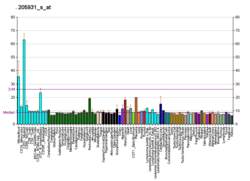| CREB5 |
|---|
|
| Identifiers |
|---|
| Aliases | CREB5, CRE-BPA, CREB-5, cAMP responsive element binding protein 5, CREBPA |
|---|
| External IDs | OMIM: 618262; MGI: 2443973; HomoloGene: 18215; GeneCards: CREB5; OMA:CREB5 - orthologs |
|---|
| Gene location (Human) |
|---|
 | | Chr. | Chromosome 7 (human)[1] |
|---|
| | Band | 7p15.1-p14.3 | Start | 28,299,321 bp[1] |
|---|
| End | 28,825,894 bp[1] |
|---|
|
| Gene location (Mouse) |
|---|
 | | Chr. | Chromosome 6 (mouse)[2] |
|---|
| | Band | 6 B3|6 25.9 cM | Start | 53,264,255 bp[2] |
|---|
| End | 53,677,361 bp[2] |
|---|
|
| RNA expression pattern |
|---|
| Bgee | | Human | Mouse (ortholog) |
|---|
| Top expressed in | - synovial joint
- ventricular zone
- blood
- corpus callosum
- tendon of biceps brachii
- monocyte
- inferior ganglion of vagus nerve
- synovial membrane
- internal globus pallidus
- cartilage tissue
|
| | Top expressed in | - hand
- ascending aorta
- aortic valve
- foot
- lumbar subsegment of spinal cord
- hair follicle
- ventricular zone
- genital tubercle
- external carotid artery
- internal carotid artery
|
| | More reference expression data |
|
|---|
| BioGPS |  | | More reference expression data |
|
|---|
|
| Gene ontology |
|---|
| Molecular function | - DNA binding
- protein binding
- metal ion binding
- nucleic acid binding
- DNA-binding transcription factor activity
- DNA-binding transcription factor activity, RNA polymerase II-specific
| | Cellular component | - extracellular exosome
- nucleus
| | Biological process | - positive regulation of transcription, DNA-templated
- regulation of transcription, DNA-templated
- transcription by RNA polymerase II
- transcription, DNA-templated
- regulation of transcription by RNA polymerase II
| | Sources:Amigo / QuickGO |
|
| Orthologs |
|---|
| Species | Human | Mouse |
|---|
| Entrez | | |
|---|
| Ensembl | | |
|---|
| UniProt | | |
|---|
| RefSeq (mRNA) | |
|---|
NM_001011666
NM_004904
NM_182898
NM_182899 |
| |
|---|
| RefSeq (protein) | |
|---|
NP_001011666
NP_004895
NP_878901
NP_878902 |
| |
|---|
| Location (UCSC) | Chr 7: 28.3 – 28.83 Mb | Chr 6: 53.26 – 53.68 Mb |
|---|
| PubMed search | [3] | [4] |
|---|
|
| Wikidata |
| View/Edit Human | View/Edit Mouse |
|

















